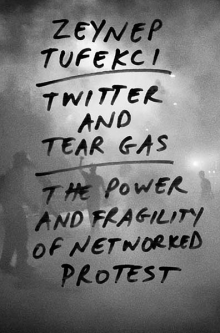
A social movement is a loosely organized effort by a large group of people to achieve a particular goal, typically a social or political one. This may be to carry out a social change, or to resist or undo one. It is a type of group action and may involve individuals, organizations, or both. Social movements have been described as "organizational structures and strategies that may empower oppressed populations to mount effective challenges and resist the more powerful and advantaged elites". They represent a method of social change from the bottom within nations. On the other hand, some social movements do not aim to make society more egalitarian, but to maintain or amplify existing power relationships. For example, scholars have described fascism as a social movement.

Youth activism is the participation in community organizing for social change by persons between the ages of 15–24. Youth activism has led to a shift in political participation and activism. A notable shift within youth activism is the rise of “Alter-Activism” resulting in an emphasis on lived experiences and connectivity amongst young activists. The young activists have taken lead roles in public protest and advocacy around many issues like climate change, abortion rights and gun violence. Different from past protest or advocacy, technology has become the backbone to many of these modern youth movements. It has been shown in multiple studies that internet use along with seeking information online is shown to have positive impacts on political engagement. Popular applications like Twitter, Instagram and YouTube have become the newest tools for young activists in the 21st century. Technology and the use of digital media has changed the way youth participate in activism globally, and youth are more active in media than older generations.
Internet activism involves the use of electronic-communication technologies such as social media, e-mail, and podcasts for various forms of activism to enable faster and more effective communication by citizen movements, the delivery of particular information to large and specific audiences, as well as coordination. Internet technologies are used by activists for cause-related fundraising, community building, lobbying, and organizing. A digital-activism campaign is "an organized public effort, making collective claims on a target authority, in which civic initiators or supporters use digital media." Research has started to address specifically how activist/advocacy groups in the U.S. and in Canada use social media to achieve digital-activism objectives.

Slacktivism is the practice of supporting a political or social cause by means such as social media or online petitions, characterized as involving very little effort or commitment. Additional forms of slacktivism include engaging in online activities such as "liking," "sharing," or "tweeting" about a cause on social media, signing an Internet petition, copying and pasting a status or message in support of the cause, sharing specific hashtags associated with the cause, or altering one's profile photo or avatar on social network services to indicate solidarity.

Media activism is a broad category of activism that utilizes media and communication technologies for social and political movements. Methods of media activism include publishing news on websites, creating video and audio investigations, spreading information about protests, or organizing campaigns relating to media and communications policies.
The Internet is accessible to the majority of the population in Egypt, whether via smartphones, internet cafes, or home connections. Broadband Internet access via VDSL is widely available. Under the rule of Hosni Mubarak, Internet censorship and surveillance were severe, culminating in a total shutdown of the Internet in Egypt during the 2011 Revolution. Although Internet access was restored following Mubarak's order, government censorship and surveillance have increased since the 2013 coup d'état, leading the NGO Freedom House to downgrade Egypt's Internet freedom from "partly free" in 2011 to "not free" in 2015, which it has retained in subsequent reports including the most recent in 2021. The el-Sisi regime has ramped up online censorship in Egypt. The regime heavily censors online news websites, which has prompted the closure of many independent news outlets in Egypt.

A hashtag is a metadata tag that is prefaced by the hash symbol, #. On social media, hashtags are used on microblogging and photo-sharing services such as Twitter or Tumblr as a form of user-generated tagging that enables cross-referencing of content by topic or theme. It is still sometimes known as the pound sign. For example, a search within Instagram for the hashtag #bluesky returns all posts that have been tagged with that term. After the initial hash symbol, a hashtag may include letters, numerals, or underscores.
Twitter Revolution is a term used to refer to different revolutions and protests, most of which featured the use of the social networking site X, formerly and commonly called Twitter by protesters and demonstrators in order to communicate.
Networked feminism is a phenomenon that can be described as the online mobilization and coordination of feminists in response to sexist, misogynistic, racist, and other discriminatory acts against minority groups. This phenomenon covers all possible definitions of what feminist movements may entail, as there have been multiple waves of feminist movements and there is no central authority to control what the term "feminism" claims to be. While one may hold a different opinion from another on the definition of "feminism", all those who believe in these movements and ideologies share the same goal of dismantling the current patriarchal social structure, where men hold primary power and higher social privileges above all others. Networked feminism is not spearheaded by one singular women's group. Rather, it is the manifestation of feminists' ability to leverage the internet to make traditionally unrepresented voices and viewpoints heard. Networked feminism occurs when social network sites such as Facebook, Twitter and Tumblr are used as a catalyst in the promotion of feminist equality and in response to sexism. Users of these social media websites promote the advancement of feminism using tools such as viral Facebook groups and hashtags. These tools are used to push gender equality and call attention to those promoting anything otherwise. Online feminist work is a new engine of contemporary feminism. With the possibility of connecting and communicating all around the world through the Internet, no other form of activism in history has brought together and empowered so many people to take action on a singular issue.
Feminist Digital Humanities is a more recent development in the field of Digital Humanities, a project incorporating digital and computational methods as part of its research methodology. Feminist Digital Humanities has risen partly because of recent criticism of the propensity of Digital Humanities to further patriarchal or hegemonic discourses in the Academy. Women are rapidly dominating social media in order to educate people about feminist growth and contributions. Research proves the rapid growth of Feminist Digital Humanities started during the post-feminism era around from the 1980s to 1990s. Such feminists’ works provides examples through the text technology, social conditions of literature and rhetorical analysis. Feminist Digital Humanities is aimed to identify and explore women's sense of writing as well as to prove widespread of women's work in most of the digital archive.

Activism consists of efforts to promote, impede, direct or intervene in social, political, economic or environmental reform with the desire to make changes in society toward a perceived greater good. Forms of activism range from mandate building in a community, petitioning elected officials, running or contributing to a political campaign, preferential patronage of businesses, and demonstrative forms of activism like rallies, street marches, strikes, sit-ins, or hunger strikes.
Hashtag activism refers to the use of Twitter's hashtags for Internet activism. The hashtag has become one of the many ways that social media contributes to civic engagement and social movements. The use of the hashtag on social media provides users with an opportunity to share information and opinions about social issues in a way that others (followers) can interact and engage as part of a larger conversation with the potential to create change. The hashtag itself consists of a word or phrase that is connected to a social or political issue, and fosters a place where discourse can occur. Social media provides an important platform for historically marginalized populations. Through the use of hashtags these groups are able to communicate, mobilize, and advocate for issues less visible to the mainstream.

The role of social media in the Arab Spring, a revolutionary wave of demonstrations and protests in the Middle East and North Africa between 2010 and 2012, remains a highly debated subject. Uprisings occurred in states regardless of their levels of Internet usage, with some states with high levels of Internet usage experiencing uprisings as well as states with low levels of Internet usage.
Fourth-wave feminism is a feminist movement that began around 2012 and is characterized by a focus on the empowerment of women, the use of internet tools, and intersectionality. The fourth wave seeks greater gender equality by focusing on gendered norms and the marginalization of women in society.
In the United States, LGBT youth of colour are marginalized adolescents in the LGBT community. Social issues include homelessness; cyberbullying; physical, verbal and sexual abuse; suicide; drug addiction; street violence; immigration surveillance; engagement in high-risk sexual activity; self-harm, and depression. The rights of LGBT youth of colour are reportedly not addressed in discussions of sexuality and race in the larger context of LGBT rights.

Twitter and Tear Gas: The Power and Fragility of Networked Protest is a 2017 non-fiction book written by Zeynep Tufekci about protest in the age of the internet, social networks, and social media. Tufekci describes the internet as a new type of digital public sphere and compares protest movements throughout history to modern movements that used the internet. The book is freely available under a Creative Commons license.
#HimToo is a social movement supporting male victims of sexual assault and false rape allegations. This reaction to the MeToo movement started in October 2018 after a tweet from a mother about her son being afraid to date because of a climate of false rape allegations. It rose to greater prominence during the Brett Kavanaugh Supreme Court nomination. The #HimToo movement is seen as a response to the sexual assault allegations from the #MeToo movement.
Internet activism in South Korea originated in 2002, when an Internet user named Angma proposed a candlelight vigil for two girls who were killed by a U.S. military vehicle in the Yangju highway incident. Angma's post circulated widely online, mobilizing ordinary people to demand SOFA reform and an apology from President George W. Bush with peaceful candlelight protests in Kwanghwamun. Since then, the Internet has been a space for open discussion of sociopolitical issues and grassroots activism in South Korea. Other examples of Internet activism in Korea are the 2008 U.S. beef protest, anti-Chosunilbo protests, and online feminist and LGBTQ movements with hashtags.

The 2019–2020 Hong Kong protests happened as a result of the Anti-Extradition Law Amendment Bill. Some observed that it is an extension to the 2014 Umbrella Movement, and there are other underlying issues that amounted to such explosive protest, which cover the economic, social and environmental aspects. With the Chinese Government's attempt in turning Hong Kong to a semi-authoritarian regime, it sparked Hong Kong people's dissent as the Chinese Government's intervention would threaten the Rule of Law in Hong Kong. Thus, people in Hong Kong shown their resistance through protesting, and planning through the use of social media have facilitated the social movements..
The #MeToo movement emerged in China shortly after it originated in the United States. In mainland China, online MeToo posts were slowed by government censorship. On Weibo, #Metoo and #MetooinChina were both blocked for a period of time. To avoid the censorship, Chinese women using the #MeToo hashtag on social media began using bunny and bowl-of-rice emojis; "rice bunny" is pronounced mi-tu in Chinese. Feminist activist Xiao Qiqi originated the use of rice-bunny emojis for the movement. Another alternative is “River Crab” which indicates censorship. Generally, the #Metoo movement was only accessible to elite women and urban women.
















